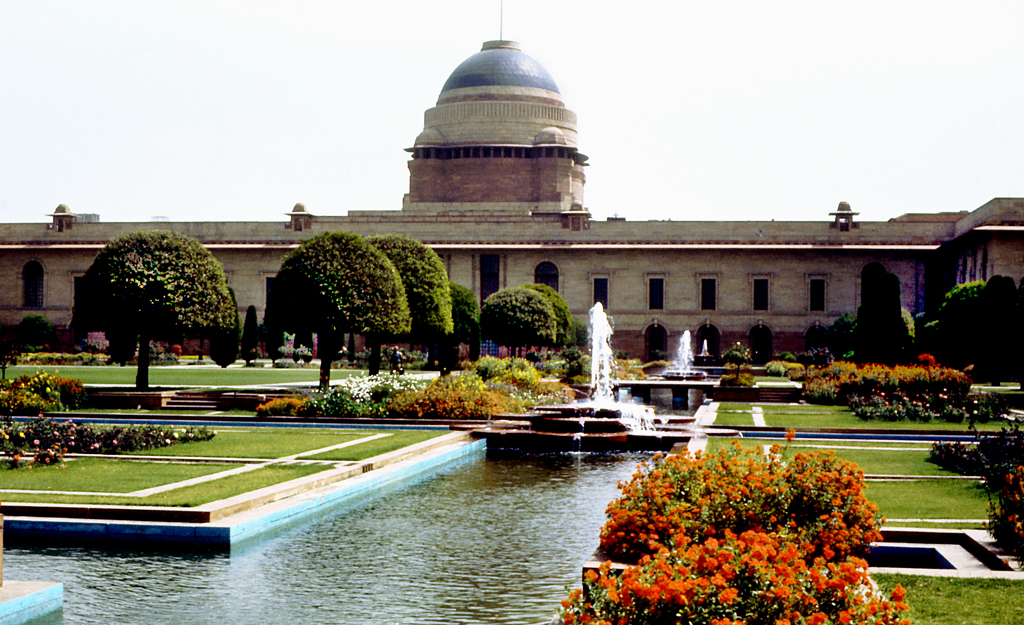
Sprawled across six hectares of the Rashtrapati Bhavan Complex, the famous Mughal Gardens were designed by Sir Edwin Lutyens for Lady Harding. These gardens combine the formal Moghul style with the British garden designs.The Gardens consist of three parts - the Rectangular Garden immediately behind the main building, the Long Garden and the Circular Garden. A virtual paradise, it has four waterways, with unique fountains at the intersections that consist of 3-tiered huge red sandstone discs resembling lotus leaves. Plots of lawn and chequered flowerbeds lend an enchanting look to this wonderfully landscaped garden. It has more than 250 rose varieties at one place, including the Benkinsian, believed to be the parent of all strains, 60 kinds of Bougainvillea, the best and largest collection of Indian marigold flowers and Dahlias of 13 different colors-some of which even look like peppermint. Besides these, there are special Moulsari trees, chosen by Lutyens because of their Indian origin. The Bonsai collection here is undoubtedly one of the finest in the country.


Sprawled across six hectares of the Rashtrapati Bhavan Complex, the famous Mughal Gardens were designed by Sir Edwin Lutyens for Lady Harding. These gardens combine the formal Moghul style with the British garden designs. Delhi Mughal Gardens sport Mughal canals, multi-level terraces and flowering shrubs along with European flowerbeds, lawns and privet hedges. W. R. Mustoe can be credited with planting the appropriate shrubs, plants and trees in the garden.

Together, the two masterminds transformed it into an oasis by 1929. The Gardens consist of three parts - the Rectangular Garden immediately behind the main building, the Long Garden and the Circular Garden. A virtual paradise, it has four waterways, with unique fountains at the intersections that consist of 3-tiered huge red sandstone discs resembling lotus leaves. Plots of lawn and chequered flowerbeds lend an enchanting look to this wonderfully landscaped garden.

In the Long Garden, there is a splendid Pergola on which bougainvillea creepers are grown. The bed of roses and trimmed hedge of Ingadulets on its sides look like colored knots on a vast carpet. The segmented, tiered flowerbeds around the pool in the Circular Garden are the best place to see butterflies. Thus, it is also known as the Pearl Garden or Butterfly Garden. The variety of flowers found here includes Rose, Viscaria, Teptosyne, Sweet William, Oxalis, Marigold and Bougainvillea and several other Annuals and Perennials.

It has more than 250 rose varieties at one place, including the Benkinsian, believed to be the parent of all strains, 60 kinds of Bougainvillea, the best and largest collection of Indian marigold flowers and Dahlias of 13 different colors-some of which even look like peppermint. Besides these, there are special Moulsari trees, chosen by Lutyens because of their Indian origin. The Bonsai collection here is undoubtedly one of the finest in the country. One can only visit these gardens during the months of February to March, except on Mondays


Together, the two masterminds transformed it into an oasis by 1929. The Gardens consist of three parts - the Rectangular Garden immediately behind the main building, the Long Garden and the Circular Garden. A virtual paradise, it has four waterways, with unique fountains at the intersections that consist of 3-tiered huge red sandstone discs resembling lotus leaves. Plots of lawn and chequered flowerbeds lend an enchanting look to this wonderfully landscaped garden.

In the Long Garden, there is a splendid Pergola on which bougainvillea creepers are grown. The bed of roses and trimmed hedge of Ingadulets on its sides look like colored knots on a vast carpet. The segmented, tiered flowerbeds around the pool in the Circular Garden are the best place to see butterflies. Thus, it is also known as the Pearl Garden or Butterfly Garden. The variety of flowers found here includes Rose, Viscaria, Teptosyne, Sweet William, Oxalis, Marigold and Bougainvillea and several other Annuals and Perennials.

It has more than 250 rose varieties at one place, including the Benkinsian, believed to be the parent of all strains, 60 kinds of Bougainvillea, the best and largest collection of Indian marigold flowers and Dahlias of 13 different colors-some of which even look like peppermint. Besides these, there are special Moulsari trees, chosen by Lutyens because of their Indian origin. The Bonsai collection here is undoubtedly one of the finest in the country. One can only visit these gardens during the months of February to March, except on Mondays

where to get generic viagra
ReplyDelete